节假日旅游外文文献
旅游的英语论文带翻译
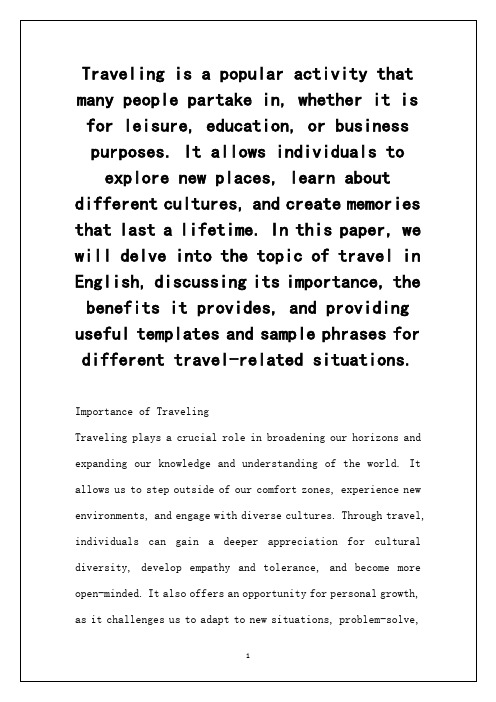
- "What are the operating hours for [attraction]?"
- "Is there a guided tour available?"
- "Are there any discounts for students or seniors?"
Traveling is a popular activity that many people partake in, whether it is for leisure, education, or business purposes. It allows individuals to explore new places, learn about different cultures, and create memories that last a lifetime. In this paper, we will delve into the topic of travel in English, discussing its importance, the benefits it provides, and providing useful templates and sample phrases for different travel-related situations.
旅游是许多人参与的一项流行活动,无论是为了休闲、教育还是商务目的。它使个人能够探索新的地方,了解不同的文化,并创造一生难忘的回忆。在本论文中,我们将深入探讨英语中的旅游主题,讨论其重要性,提供的好处,并为不同的旅行相关情景提供有用的模板和例句。
中国的假期旅游Travels on Holidaysin China_英语作文_1
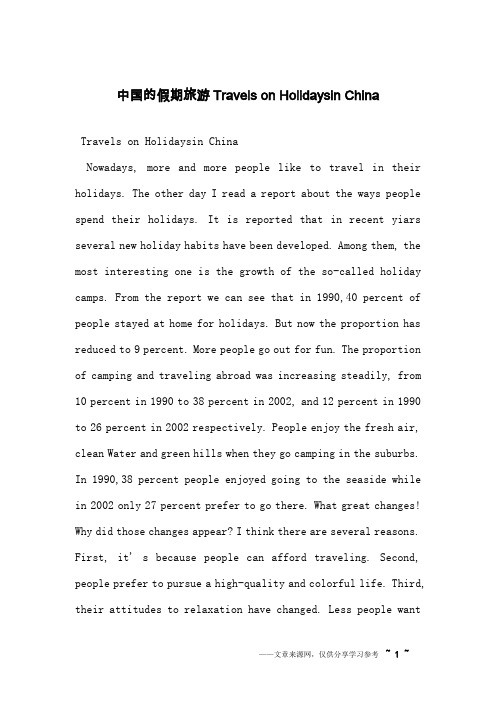
中国的假期旅游Travels on Holidaysin ChinaTravels on Holidaysin ChinaNowadays, more and more people like to travel in their holidays. The other day I read a report about the ways people spend their holidays. It is reported that in recent yiars several new holiday habits have been developed. Among them, the most interesting one is the growth of the so-called holiday camps. From the report we can see that in 1990,40 percent of people stayed at home for holidays. But now the proportion has reduced to 9 percent. More people go out for fun. The proportion of camping and traveling abroad was increasing steadily, from 10 percent in 1990 to 38 percent in 2002, and 12 percent in 1990 to 26 percent in 2002 respectively. People enjoy the fresh air, clean Water and green hills when they go camping in the suburbs. In 1990,38 percent people enjoyed going to the seaside while in 2002 only 27 percent prefer to go there. What great changes! Why did those changes appear? I think there are several reasons. First, it' s because people can afford traveling. Second, people prefer to pursue a high-quality and colorful life. Third, their attitudes to relaxation have changed. Less people wantto save much money by leading a simple life. In short, people's living standard today has been rising greatly.标题:旅游对Holidaysin中国,中国的假期旅游内容:旅游对Holidaysin中国如今,越来越多的人喜欢旅游,在他们的假期。
旅游中英文对照外文翻译文献
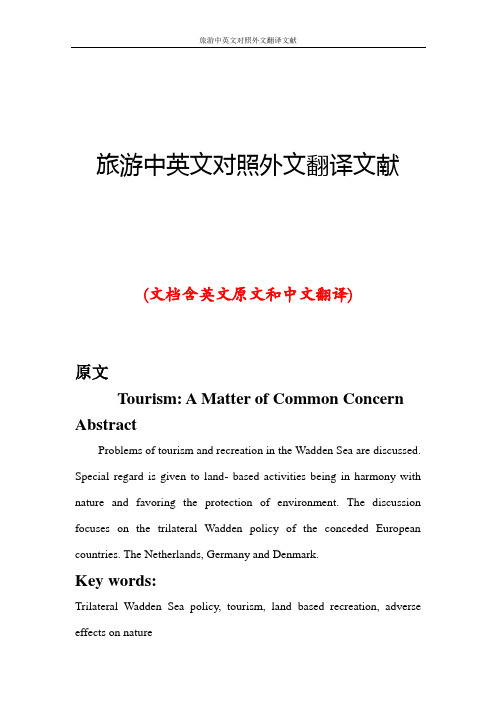
旅游中英文对照外文翻译文献(文档含英文原文和中文翻译)原文Tourism: A Matter of Common Concern AbstractProblems of tourism and recreation in the Wadden Sea are discussed. Special regard is given to land- based activities being in harmony with nature and favoring the protection of environment. The discussion focuses on the trilateral Wadden policy of the conceded European countries. The Netherlands, Germany and Denmark.Key words:Trilateral Wadden Sea policy, tourism, land based recreation, adverse effects on nature1.Why a Common Concern?In the Wadden Sea area people live, work and recreate. Trilateral Wadden policy has been mainly focused on sea- based recreation. But an activity in the Wadden area which also has a direct influence on the dunes, mudflats and tidal areas is land based recreation. Millions of people visit the area each year for leisure. Until now this has been neglected by the international Wadden policy. Because of the influence of and developments in this sector, it is necessary to widen the scope of this policy so that a strategy can be developed for all recreational activities. This implies making intelligent choices. What kind of recreational activities and accommodations fit this nature area? When and where should they take place? What amounts are in harmony with the nature we want to protect? Answers to these questions are part of a strategy for conservation of nature and recreation.In 1994, in Leeuwarden, ecological goals were drawn up not only for the tidal area, but also for the beaches and dunes, the salt marshes, the coastline and the rural areas (on the islands and the adjacent areas of the mainland). In addition, it was recognized that the trilateral policy covered a wider area than just the Wadden Sea. loss of natural habitats and the disturbance of flora and fauna as a result of increasing tourism was identified as a cause for cancel. To better understand the influence of landbased recreation on the area's natural environment, it is necessary to first consider the situation in the tourism sector. This is mainly based on the experiences obtained by the Dutch Wadden Society in the Dutch Wadden Sea region.2.A Summary of the SituationI. Since the middle of this century, the Wadden Sea area has been a popular destination for an ever growing number of tourists. Today tourists can choose from a wide range of accommodations: hotels, hiking cabins, apartments, camping sites, bungalows and so on. This development has sparked a lot of building activity; sometimes to replace old buildings, but more often for new building sites. In a number of cases this has been at the cost of dune areas.A first observation: to offer all these visitors a place to sleep more and more space is occupied. Sometimes at the cost of nature and sometimes at the cost of historical buildings or rural landscape.II. But not all visitors to the area stay overnight. On the one hand there are the day tourists to the islands. Especially the islands with a short ferry time and/or low ferry costs ate favorites. On the other hand the different recreational areas along the mainland coastline also attract a large number of day tourists, particularly in Germany. Tourists not only desire a place on the beach in the sun, but also want to walk in the dunes, buy a cup of coffee and have proper transport facilities to and from thearea. On the main land side of the ferry dam to Ameland, for example, there ate plans for a second level in the car park on the mainland to offer day tourists extra parking space close to the ferry.A second observation: day tourism leaves its marks in the landscape by facilities, over fulled ashtrays, empty beach chairs and treaded plants, also when the day is over.The short second or third holiday, a midweek break or a day to escape it all, has become reality for many. The quiet and long off-season period is a thing of the past for the local population and nature. The accommodation-branches anticipates this trend by building more and more cabins and bungalows at former camping sites. The lengthening of the holiday season has been encouraged by the development of so-called "bad weather facilities" like the tropical swimming pool. The result is that walkers and cyclists can be found on the beach or in the dunes as early as March. This can cause problems for migratory and breeding birds. Should the areas important to these birds be closed off to the public earlier in the year? That is against the idea that people should be given as many chances as possible to enjoy nature. So what is more important: undisturbed feelings of liberty or undisturbed nest building?A third observation: lengthening of the holiday season means more disturbance risk to a number of bird species.IV. Recreational activities are no longer limited to a walk breathingthe fresh sea air of a healing dip in the water. The current possibilities seem endless, a few examples: parachute jumping, golfing, "nature combing", walking on the mudflats, visiting bird colonies, seals, a wagon ride through the dunes and marshes, short aero plane trips, kiting, sunbathing, night-life, cross country cycling and so on.A fourth observation: recreational activities, even nature oriented, have more and more adverse effects on nature.The economic aspect of tourism certainly plays a role in the trilateral policy decisions. The weight that this aspect carries in the policymaking process is a choice in itself. But in what terms are we measuring the economic effects, in jobs, in regional income and investments, or in the sustainable use of nature?A fifth observation: economic aspects are part of the discussion about tourism and there is quite some cash flow related to it.3.Developments and New Trendsit When coming up with a strategy for recreational activities is important to consider developments and trends in the sector.1. Tourism is a growing industry. It is seen as a sector which can provide employment in the near future. And for this reason subsidies are given. That is an attractive proposition, particulary in regions with relatively high unemployment. Many community councils along the Dutch coast have plans to exploit tourism. These vary from building a small bungalow park to a health spa with a beach. Work is already inprogress on the islands to improve the quality of accommodation. This requires larger investments and returns.2. The trend to take a number of short holidays. The same number of over night stays are therefore being shared by more and other visitors and more transport is required.3. Hotel managers want the same bed occupied more often. The stabilization of the number of beds available (a policy on the Dutch Wadden islands) is therefore certainly not synonymous with a stabilization of recreation volume.4. The trend towards more active holidays. The activities can range from nature excursions to sport events. This raises the question whether the Wadden nature is seen as a backdrop or as a destination itself. In order to formulate a strategy on tourism we will have to take into account the five observations made.4.summarize:(I) more and more space is taken by accommodations, improving quality also requires more square meters per tourist;(II) Day tourism leaves its marks in the landscape;(III) Season lengthening means shortening of the undisturbed periods for birds;(IV) Recreation activities, even nature oriented, have more and more adverse effects on nature;(V) The tourism related cash flow is on the rise;(VI) A growing number of people visit, know and hopefully appreciate the Wadden Sea area and.., disturb each other.The importance of the international Wadden Sea area does not need to be stressed. Nor does the importance of protecting the area's natural development. Joint trilateral goals and targets have already been laid down or are receiving the final touches. Al1 we have to do, is bring about the goals. The trilateral Wadden policy can no longer ignore land based recreational activities; their effects are too far reaching. Dunes, marshes and birds are currently witnessing a loss in territory and an increase in disturbance and damage. The countryside is under attack and new building projects threaten to overshadow the cultural and historical value of the area. And sometimes there ate just too many people around.It's not enough to acknowledge that recreation is important to the area, to declare ah area a national park, to do some zoning or to fix the number of beds.A fundamental consideration is needed. What kind of recreational activates and accommodations fit this nature area?When and where can they take place? Whatamounts are in harmony with the nature we want to protect? Answers to these questions ate the start of a strategy for conservation of nature and sustainable recreation.5.The Choice of the Dutch Wadden SocietyThe Wadden Sea area offers some very special opportunities for recreation. When people get to know and appreciate an area they are more willing to protect it. And from the perspective of tourism it is nature, the openness, the birds, the unique landscape and the historic cultural values that makes .this area into something singular and special. These are the selling points of the Wadden Sea area on the touristic market. In our view there should be possibilities to experience that specific Wadden Sea nature. This means Wadden nature" oriented recreation. But in such a way that it is and continues respecting nature. This is of course something totally different from island hopping by aero plane or a disco party on the beach.What such a choice means from a sustainable and economic perspective is of course an important question. Does it mean more visitor management, more excursion leaders and less disc jockey? More bird watches facilities and wardening and less recreational air traffic and tropical swimming paradises? These aspects definitely need moreresearch. The Dutch Wadden Society has taken initiatives in this direction but we certainly cannot cover this alone.To formulate such a strategy it is vital that there is a complete picture, based on comparable data, of recreation in the international Wadden area. At this moment data are still incomplete. So from our point of view the following steps lead to a strategy for conservation of nature and of sustainable possibilities for recreation:- identify the processes and areas which need extra protection. -identify the unique opportunities the area offers. -identify frictions between existing tourism and nature conservation goals. -select the types of tourism and recreational activities that can be accommodated in harmony with the area and the goals. -make choices regarding: "when', "where" and "what amounts'. - formulate clear policy goals. - develop indicators to monitor and -execute itTime is ripe to make choices and there are already some hopeful initiatives. In "Nord Friesland a "Zukunftswerkstatt Tourism’s und Umwelt" is being drawn up with the aim to elaborate concepts for "umbel- und sozialvertrigliche Tourismusentwicklung'.The Dutch, German and Danish province and regions along the Wadden Sea started a project to develop a vision on sustainable tourism. The trilateral Wadden policy can encourage these initiatives. In 1997, in State, there should be an acknowledgement of the importance and effects of land based recreation at a trilateral level. It must be possible to developa common strategy for all tourism and recreation activities in the trilateral Wadden area, particularly in the light of the ecological and landscape goals that have already been agreed on in the past and which also reflect the recreational interests.译文:旅游业共同关心的问题摘要旅游业协会针对瓦登海问题进行了讨论,讨论的内容是关于陆地活动与自然和谐以及环境的保护。
大学生论文旅游发展外文文献

Measuring the Impact of Tourism upon Urban Economies:A Review of LiteratureKTHC – Knowledge, Technology, Human CapitalUgo Gasparino, Elena Bellini, Barbara Del Corpo and William MaliziaAbstractTourism is increasingly seen as a potential lever towards high economic growth, measured both in terms of income and employment. In recent years, interest in tourism has spread rapidly throughout many small and medium European cities, which previously have not considered themselves as tourist destinations. This paper reviews and summarizes the existing literature on the economic assessment of tourism with the objectives of, firstly, identifying the main categories of impacts and, secondly, constructing an inventory of methodologies available to assess them. We will progress step by step, starting from the most simplistic approaches and relaxing assumptions as we proceed. Firstly, we assume a static setting, with spare capacity. In such a setting (partial equilibrium), prices do not respond to demand shocks: only quantities (production, income and jobs) adjust. Secondly, we relax this assumption and assume that there is no spare capacity: prices respond to increasing demand (general equilibrium), leading to reallocation of resources across sectors. We then move from a static to a dynamic setting and survey those contributions that look at the relationship between tourism specialisation and long-run growth.Keywords: Tourism, Economic Impacts, Input-Output Analysis, General and PartialEquilibrium Analysis1 The partial equilibrium analysisPartial equilibrium analysis assumes that there is spare capacity unemployed resources and that, as a consequence, prices do not respond to increasing demand (perfect elastic supply). Adjustment takes place only through quantities (production, jobs, and therefore income).The basic concept of partial equilibrium analysis is that of ‘multiplier’ although, as noticed by Archer, «there is perhaps more misunderstanding about multiplier analysis than almost any other aspect of tourism research» (Archer, 1982). Multipliers measure the present economic performance of the tourism industry and the effects of short-run economic adjustments to a change in the level of tourist expenditure.The definition of multiplier, in terms of Keynes, is unequivocal: the multiplier measures the increase in economic activity generated in an economy by a unit increase in tourismgenerated in an area by an additional unit of tourist spending: for instance, if tourists spend an extra EUR 1 million in the area and this generates EUR 800,000 of income, the Keynesian multiplier is 0.81. However, alternative definitions of multipliers can be found in tourism literature. The mo st popular of these is the use of ‘ratio’ multiplier, where for example the income multiplier tends to be expressed as the ratio of a ‘total’ income generated by tourism expenditure (see Section 1.1) to the ‘direct’ income. Depending on what is meant by ‘total’ income, three types of ‘ratio’ multipliers can be generated.Despite the strong assumptions implicit in their calculation, multipliers are widely used in policy-making. They are used to study the impact of tourism on business turnover, income and employment and can be used to compare the impact of increased demand on other sectors of the economy or different policy options.In what follows, we firstly introduce the economic meaning of multipliers, analysing how the tourist expenditure ripples through the economy. Secondly, we present two widely used methodologies to calculate multipliers. Finally, we briefly discuss and compare some of the empirical results.2 The economic meaning of multipliersIn the destination tourists spend their money to buy certain goods and services. This initial tourist expenditure is generally directed to very specific sectors of the economy (lodging, restaurant, amusement, retail trade, transportation – which we will refer to asAlthough the correct methodology would require the calculation of the multiplier at the margin, it is common practice (mainly because of data limitation) to calculate income effects in terms of average, rather than marginal, tourism expenditure and to assume that there is no significant difference between them. This implies that the economy has available capacity to meet future demandTourism industries and represents additional revenues for these activities. These are the so-called direct effects.Part of those revenues is used to buy intermediate goods and services that will be used in ‘future production cycles’ (intermediate demand). A remaining part will be used to buy the services of production factors: labour, capital and land (wages, interests and profits, and rents –gross value added), to pay taxes to central and local governments, or saved. In all cases, some money could go outside the area, to intermediate producers and production factors located outside the area (i.e., it ‘leaks’ out of the local economy).However, some will remain within the area: local tourism industries will hire new localworkers (paying a bigger number of wages) and demand additional goods from local producers. As a result, local output increases, employment opportunities increase and local income rises (due to the increase in the number of wages). These are the so-called indirect effects.The increase in employment brings to an increase in the total income of local residents.Part of this income is saved and part is spent in consumption goods. This in turn generates additional demand which, as before, translates into additional production and employment (and so on). These are the so-called induced effects. Indirect and induced effects are often called secondary effects. The effect of tourism on the local economy is influenced by a few key factors: The characteristics and the spending patterns of the local tourists, affecting the direct impact on the economy. Essential features here include: The reason for travel (tourists travelling for cultural reasons spend more/less and put more/less pressure on natural and cultural resources than sun&beach tourists);The length of stay (tourists staying for the day are likely to spend a smaller share of total expenditure in locally produced goods); The accommodation chosen (hotels are more expensive than campsites).The characteristics of the tourism industries and of the local economy. Key features here include the ability of local economy to satisfy the demand of tourism industries, as well as the size and the shares of tourism industries that are locally owned. The extent of the indirect effects depends on the size of the area under study (e.g., municipal, regional, national) and on the extent to which business firms in the area supply each other with goods and services (the more likely the more diversified and interlinked is the local economy). In general, the smaller the scale of the economy and the higher the share of initial expenditure that leaks out of the local area, the fewer are these linkages and the smaller are the indirect effects. Moreover, the magnitude of indirect and induced effects depends on the share of capital, land and labour that is locally owned. For instance, small family-owned hotels and restaurants are more likely to buy local intermediate inputs than chain hotels and tourist villages. If factors are locally owned, their remunerations – profits, rent and wages – will stay locally and local community will strongly benefit from them.3. Direct, indirect and induced benefits and effects on the economy triggered by touristSpending Several types of multiplier are commonly used:Sales (or transactions) multiplier refers to the effect on business turnover (value of business turnover created by a unitary increase in tourism expenditure); Output multiplier refers to the effect on the level of output of the economy. With respect to the sales multiplier it does not only take into account the impact on turnover of local businesses, but also any changes in the level of stocks they hold. This can be useful in identifying potential supply shortfalls, or bottlenecks; Government revenue multiplier refers to the effects on governmental revenues from all sources (e.g., direct and indirect taxation, duties, licenses and fees); Income multiplier refers to the effect on incomes (sales net of intermediate consumption, including wages, salaries and profit). This is commonly regarded as the most important indicator of the economic performance of tourism industry. Income multipliers vary depending on whether they include or not incomes accruing to nonnationals residing in the region under investigation, and whether they include or not income accruing to governments. The multiplier can be measured as disposable income –the income available to individuals to spend or save, which is net of tax – or value added income – the income which includes tax and other expenditures which are defined according to national income accounting rules; Employment multiplier refers to the effect on employment. It is usually derived from the output or income multipliers. It can be expressed as the ratio of the number of ‘total’ additional jobs (e.g., direct and indirect or direct and secondary) to either the number of direct jobs (‘ratio’ multiplier) or to the initial tourist expenditure(Keynesian multiplier). Employment can be measured in terms of full time equivalent jobs, or the actual number of jobs including part-time jobs.Suppose additional tourist expenditure of EUR 1 million generating EUR 2.5 million of extra output and EUR 500 000 of direct and secondary income. It also creates 200 jobs directly and 180 secondarily. In Keynesian terms the multipliers are, respectively: 2.5 (output), 0.5 (income) and 3.8 jobs for 10 000 EUR of tourist expenditure (employment).On the other side employment, in terms of ‘ratio’ multipliers (i.e., total employment generated to direct employment) can alternatively be expressed as 1.9 (i.e., 380/200).The various multipliers are inextricably linked to each other. Sales and Output multipliers have limited use from the policy point of view, except as an indicator of the degree of economic internal linkages. On the other side, it is important for policymakers to be aware of the income and employment effects of any anticipated changes in final demand, making income and employment multipliers the most often quoted types of multipliers.Multipliers are not only influenced by the economy and tourism characteristics of the area ofconcern, but they also reflect its size (and population). Studying the impact of local tourism one of the most common errors, when the available resources do not allow independent and consistent estimations, is to ‘borrow’ multipliers evaluated at national scale (or in areas erroneously considered to be ‘equivalent’ to the area of concern) and to apply them uncritically to sub-national areas (e.g., municipalities, regions). The use of national multipliers tends usually to yield inflated estimates of impacts.The model is static and assumes that there are (unlimited) idle resources (including labour, natural resources and capital goods), which means that any increase in final demand can simply be met by proportionally increase in sectoral outputs. As a consequence, prices do not respond to increasing demand (perfect elastic supply) and the growth of tourism do not lead to a reallocation of resources across sectors. Even granted that in most economies there is some unemployment of labour, this assumption seems rather unlikely. The ability of the economy of a study area to respond immediately to changes in final demand (i.e., the absence of capacity and supply constraints) has seriously been questioned by many researchers (Briassoulis, 1991);Technologies are fixed. All firms in each sector employ the same technology, and there are neither economies nor diseconomies of scale and no substitution among inputs;The outputs of each sector are homogeneous. An industrial sector cannot increase the output of one specific product unless it proportionally increases the output of all its other products;In calculating the employment effect, the model assumes a fixed employment/output ratio. Productivity increases are not taken into consideration (any additional demand for labour translates into a proportional increase in the number of employees);It is a ‘data hungry’ methodology, as it relies on the existence and availability of a reliable case study-specific I-O matrix;The I-O matrix approximates the actual economy with respect to the year it is estimated. The farther away we are from the I-O table year, the less the evaluation corresponds to actual economy. Tourism, as any economic activity, passes through several stages during its development. The early stages of tourist development of an area are characterized by dynamic, short-term changes implying that technical coefficients do not remain stable at least for some period. Furthermore, tourism can induce developments and infrastructures in the host region that otherwise would not probably occur. As a tourist region matures, the assumption of constant coefficients may be more acceptable (but the coefficients cannot be assumed to remain constant for time periods longer than, typically, five years). At the level of multipliers,it has to be noticed that the income multiplier, expressed as ratios of money to money may not significantly change over time; Keynesian employment multiplier, however, being expressed as a ratio of number of employees to tourism expenditures, will be affected by inflation. These limitations become increasingly binding the greater the simulated change in demand. Although real world production relationships are most probably non-linear, it is not unreasonable to approximate these with linear specifications as long as the changes from the starting point remain relatively small. On the other hand, simulations that involve drastic changes from the means are likely to have poor predictive abilities.Despite of these limitations, an understanding of the caveats can help the analyst to overcome the weaknesses.Depending on the characteristics of the area of concern and on the tourist spending patterns, the assumptions at the base of I-O analysis could bias the values of the derived tourism multipliers (Fletcher, 1989; Briassoulis, 1991). As already noticed, for the employment multiplier values to hold true, it must be assumed that an increase in final demand will result in each sector increasing their demand for labour in a linear way. This will only be reasonable if every sector is operating at full utilization. Any underutilization will mean that sectors can expand output without resorting to employing additional staff. In the short run it is likely that most sectors will meet additional demand by either better utilization of existing personnel or by increasing over-time. In such cases, the employment multiplier will over-estimate the effects on employment. This can be particularly critical in the case of tourism, where the restaurant & hotel industry is typically characterized by capacity under-utilization (reflected in hotel occupancy rates lower than 100%). This means that additional tourists can be accommodated by existing hotels and restaurants with only a marginal increase in employment and in the inputs required from the other sectors of local economy. Further difficulties inherent to the assessment of employment impacts are related to seasonality problems (particularly important for sun&beach tourism) and to the fact that it is very common in tourismrelated establishments that many people employed in tourism also hold another job and part-time employment.Furthermore, it is also quite conceivable that some industries will not be able to respond to an increase in demand (particularly in the short-term run) and any increase in demand will need to be met by an increase in imports rather than an increase in the level of output of the domestic industries.There is a wide range of literature on (tourism) multipliers. We do not aim at discussing allfindings, but rather at identifying those factors that influence the values of multipliers and that might be relevant to our discussion. We will firstly discuss issues relative to the calculation of multipliers. This part will help to clarify some of the definitions presented in previous sections and to assess the range of changes involved with the different definitions. Secondly, we will discuss issues relative to the destination regions (and how they influence the value of multipliers). This will help to clarify the regional factors that we need to take into consideration in the empirical studies. Thirdly, we will discuss the relevant features of tourism and tourists’ patterns. This is very relevant for policy-making in the field of tourism; different strategic choices must be compared. Finally, we willdiscuss the issues concerning the impact on employment.Caution must however be exercised when comparing quantitatively multipliers from different studies, since multipliers might have been generated by different methodologies, include different assumptions, reflect different distributions of expenditures (e.g., more on hotel, less on shopping).Types of multiplier and their range of values.Multipliers have been widely used in research and policy support. However, their use has been often characterized by confusion and misunderstanding concerning the typologies of the used multipliers (Archer, 1982). Here we discuss the range of changes in empirical findings involved when different typologies of multipliers are used.A first distinction refers to the range of effects taken into account by the multiplier. In Singapore, income and output multiplier increase by 30% when induced effects are included (Heng and Low, 1990); the increase in the income multiplier, when also induced effects are considered, is found by Del Corpo et al (2008) to vary from 20% in Sicily to 65% in Spain. Feedback effects from surrounding regions can also be considered. Sinclair and Sutcliffe (1988) take into account feedback effects from surrounding economies and show that the size of multiplier increases by 2-7%.The second distinction refers to the affected variable (sales, output, income or employment multiplier). This is a simple and clear issue, but it is very relevant when comparing different values of multipliers. It is important to note that different definitions of multipliers are relevant for different policy objectives. The relevant multipliers should be therefore chosen when comparing different policy options with respect to a specific objective (either the maximisation of the employment, income or government revenues effect). Sales and output multipliers tend to be around the double of income multipliers (Heng and Low, 1990).Multipliers and features of destination regionThe value of the multipliers crucially depends on leakages, and therefore on the share of imports to total output. In turn, the share of import is heavily dependent on the size of theregion (small economies are relatively less self-contained than larger economies). In the specific case of tourism multipliers, the interrelationships of tourism industries with the rest of the local economy (and specifically the extent to which demand from tourism industries is satisfied with imports), is also a crucial factor.Income multipliers reach a maximum for large countries such as Turkey and the UK and in self-contained small island economies (Jamaica, Mauritius), where they vary in the range 0.50-1.20. They are just smaller for US0.90 – Archer, 1988), but sensibly lower in very open regional and urban economies such as US and UK counties (range 0.20-0.50 – Fletcher, 1989; Archer, 1982). Baaijens et al (1998) analyzed statistically (regression models) income multipliers extracted from 11 studies. A positive relationship was found with the logarithm of the population (several alternative regional characteristics –as area size, number of tourist arrivals – were also tested). A similar result was found by Chang (2001), analyzing more than 100 regional IO models varying in size and economic development (covering five US-states: California, Colorado, Florida, Michigan and Massachusetts), generated by means of the IMPLAN I-O modelling system. A ‘tourism multiplier’ was defined as a weighted sum of multipliers derived from four tourism-related sectors (lodging, eating and drinking, recreation and retail). For all the four analyzed Type II ‘tourism multipliers’ (sa les, income, value added and job) the most significant predictor, in a stepwise regression analysis, was found to be the logarithm of population. While sales, income and value added multipliers increased almost linearly with the logarithm of population, the employment multiplier showed a negative correlation (interpreted on the basis that, in the contest of the analyzed dataset, regions characterized by a smaller number of inhabitants tend to correspond to less economically developed rural areas). Using hotels as an example, higher job to sales ratio could be a result of lower room rates, or more part-time and seasonal jobs (resulting in lower average wages). Type II multipliers vs. Log (Population) for 114 US regions. The empty diamonds report the results obtained through I-O modelling (IMPLAN), while the squares correspond to the corresponding results from a statistical regression analysis with Log (Population) as dominant predictors. The lines report empirical multipliers proposed from a straightforward classification of the different regions in: ‘rural’, ‘small me tro’, ‘large metro’ and ‘State’. Multipliers and features of tourism and tourists’ patternsTourists differ in behavioural and expenditure patterns. This has consequences for the size and range of economic effects. This question is crucial when confronting different policy choices for tourism development (e.g., privileging short vs. long stays, beach resort vs. cultural tourism, etc.). Two key issues must be taken into account here.Firstly, the impact on the local economy varies not only depending on the value of the multipliers, but also on the value of the multiplicand: even if the multiplier is high, the final impact on local income will be low if the direct injection of tourist expenditure in the destination region is low. Previous research shows that tourist spending taking place through tour operators, international airlines and chain hotels often leaks out immediately without even reaching the destination economy. For example, only 42% of the price of a package holiday was received by Spain when tourists travelled on a non-Spanish airline (Istituto Espanol de Turismo, 1987). Similar results hold for Kenya: only 38% of UK tourists’ spending travelling in package holidays reached Kenya.Improving options locally available to tourists would magnify the size of economic impacts. In the case of Kenya, the use of local airlines could considerably increase the share of expenditure accruing to the Country: up to 66% if local airlines are used for internal travels, up to 80% if Kenyan airlines are used for international flights also (Sinclair, 1991). Secondly, the impact on the local economy varies with the patterns of tourist’s expenditure, in turn influenced by the motivation of the trip (pleasure vs. business, for example), the nationality of tourists, the accommodation chosen. Research shows that accommodation is a key factor, as confirmed among others by Del Corpo et al (2008). Sinclair and Sutcliffe (1988) find that the income multiplier in Malaga is lower for tourists staying in flats or villas and higher for tourists staying in hotels. This is due to the different relationships that these types of accommodation create with the local economy.On the contrary, the nationality of the tourist does not seem to be so relevant. Archer and Fletcher (1996) find no evidence that nationality of tourists made a significant difference to the size impact of tourism on the economy of Seychelles. The difference is found to be negligible also in the three case studies used by Del Corpo et al (2008), that is Bergen, Elche and Syracuse, even though in general Spanish tourists in Elche present a higher direct impact than foreigners. Finally, Heng and Low (1990) find no evidence that tourists from developing countries had a different impact than tourists from developed countries.The impacts on employmentThe ability of tourism to create jobs is of high relevance for policy-makers.As discussed in Section 1.1, employment multipliers are easily calculated in multiplier exercises. The values of the multiplier are influenced by the same factors discussed in previous sections, and therefore differ quite widely. Heng and Low (1990) find that tourism in Singapore creates over 30 jobs per million dollar of expenditure when induced effects are included and just above 25 jobs when only direct and indirect effects are calculated. Fletcher (1989) finds a similar value for Jamaica. He shows that values might be even higher for smaller economies such as Gibraltar, where he also finds that the employment multiplier of tourism expenditure is nearly the double than Ministry of Defence and other Government departments’ expenditure.Sinclair (1998) discusses few additional features concerning employment effects of tourism (based both on case studies and multiplier analysis):Tourism industries are relatively skill-intensive. This was pointed out by Diamond (1974), in his research on Turkey, and confirmed by following studies. Delos Santos etal (1983) further noticed that only 16% of employment in the tourism sector in the Philippines was unskilled and that nearly 40% was semi-skilled;Much of the employment in the catering and accommodation is on a part-time seasonal basis or family-related without a formal wage. Sinclair and Bote Gomez (1996) find that just below 10% of part-time workers in hotels and guesthouses in Spain were without a formal wage. Farver (1984) finds that hotel employment in Gambia nearly doubled in the high season with respect to the low season. He also finds that top managerial posts are usually occupied by foreigners. This appears to be true also for the Fiji Islands (Samy, 1975). However, in Kenya this trend has been reversed and top managerial posts are now being taken by residents (Sinclair, 1990).These results point out to potential important employment gains from tourism, under both a quantity and a quality perspective (although seasonality remains a problem).4 ConclusionsBased on the review of literature, we can propose a rather general classification of the impacts of tourism on urban economies:The impacts that take place through market interactions;The impacts that do not involve market interactions;The key issues that affect the size and sign of the impacts.4.1 Impacts taking place through market interactionsTourists typically demand a set of services and goods. Some of these are provided by themarket, such as restaurants, hotels, private transportation (we referred to them as tourism industries). This additional demand generates a series of impacts on the local economy: Increased expenditure by tourists increases local production (and incomes). Assuming that there is idle capacity (and prices do not respond to increased demand), the final increase is bigger than the initial increase (multiplier effect);The additional income brings with it additional jobs: directly, in the tourism sector and indirectly in the sectors serving the tourism sector;When relaxing the assumption of idle capacity, prices (as well as quantities) respond to the additional demand. Theory shows that, finally, the benefits of tourism are capitalized in higher prices of non-tradable sectors (hotels, restaurants, houses, prices of locally produced goods) and that they finally accrue to the immobile factors (e.g., land) employed in the non-tradable sector (which is able to charge higher prices).The above effects imply that there is a distributional issue, as tourism leads to a contraction of the traded sector (e.g., manufacturing) and to a decrease of real returns to all the other factors; The structural change induced in the economy may affect its capability to grow in the long run. The crucial question is whether a region relatively specialized in tourism will grow slower or faster than, for example, regions specialized in knowledge intensive industries. Theoretically, the answer depends on the long-run dynamics of prices of tourist goods compared to, for example, knowledge-intensive goods.4.2 Impacts taking place through non-market interactionsTourists do not only demand goods and services provided by the market. They also demand access to natural and cultural resources and to publicly provided goods and services (such as water, public transportation, health and security, a clean environment).This additional demand generates the following impacts.Firstly, the additional pressure on natural and cultural resources can lead to their overexploitation and degradation.Secondly, the pressure on public services will also increase, as a consequence of the additional demand for water, waste and water treatment, public transportation. The additional costs will be compensated (to some extent) by an increase of fiscal revenues following the increase of incomes and jobs.Thirdly, there is a pure external effect in terms of the congestion (noise, traffic jams) caused by the arrival of tourists.From the discussion above it follows that the size and sign of impacts will depend on the。
国庆假期行程范文英文作文

国庆假期行程范文英文作文英文:During the National Day holiday, I went on a trip to Yunnan province with my family. Yunnan is a beautiful place with diverse landscapes and cultures.We started our trip in Kunming, the capital city of Yunnan. We visited the famous Stone Forest, which is a natural wonder of limestone formations. It was truly breathtaking to see the towering rocks and explore the maze-like paths.Next, we went to Dali, a charming ancient town with a rich history and culture. We strolled along the cobblestone streets, visited the ancient city walls, and enjoyed the local delicacies.Then, we traveled to Lijiang, a UNESCO World Heritage Site known for its well-preserved old town and traditionalNaxi culture. We walked around the ancient alleys, visited the Mu Palace, and watched a Naxi music performance.Finally, we ended our trip in Shangri-La, a mystical and remote town in the northwest of Yunnan. We visited the Songzanlin Monastery, hiked in the Tiger Leaping Gorge, and experienced the Tibetan culture.Overall, it was an unforgettable trip filled with stunning scenery, delicious food, and cultural experiences.中文:国庆假期,我和家人一起去了云南旅行。
旅游英语论文总结范文
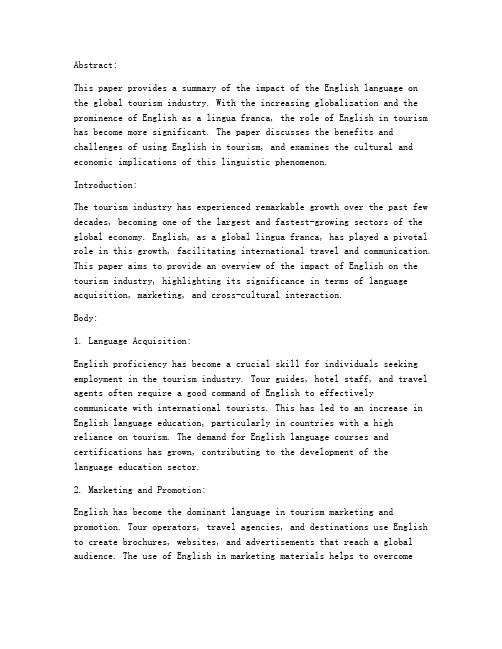
Abstract:This paper provides a summary of the impact of the English language on the global tourism industry. With the increasing globalization and the prominence of English as a lingua franca, the role of English in tourism has become more significant. The paper discusses the benefits and challenges of using English in tourism, and examines the cultural and economic implications of this linguistic phenomenon.Introduction:The tourism industry has experienced remarkable growth over the past few decades, becoming one of the largest and fastest-growing sectors of the global economy. English, as a global lingua franca, has played a pivotal role in this growth, facilitating international travel and communication. This paper aims to provide an overview of the impact of English on the tourism industry, highlighting its significance in terms of language acquisition, marketing, and cross-cultural interaction.Body:1. Language Acquisition:English proficiency has become a crucial skill for individuals seeking employment in the tourism industry. Tour guides, hotel staff, and travel agents often require a good command of English to effectively communicate with international tourists. This has led to an increase in English language education, particularly in countries with a highreliance on tourism. The demand for English language courses and certifications has grown, contributing to the development of the language education sector.2. Marketing and Promotion:English has become the dominant language in tourism marketing and promotion. Tour operators, travel agencies, and destinations use English to create brochures, websites, and advertisements that reach a global audience. The use of English in marketing materials helps to overcomelanguage barriers and ensures that tourists from different linguistic backgrounds can access information about travel options and destinations.3. Cross-Cultural Interaction:English serves as a bridge for cross-cultural interaction in the tourism industry. It allows tourists and locals to communicate effectively, fostering mutual understanding and respect. English-speaking touristscan navigate foreign destinations with ease, while locals can provide services and information that cater to international visitors. This linguistic exchange promotes cultural exchange and the sharing of ideas, contributing to a more interconnected world.4. Economic Implications:The use of English in tourism has significant economic implications. Countries with high English proficiency in the tourism sector canattract more international tourists, leading to increased revenue andjob creation. English proficiency can also enhance the competitivenessof destinations in a global market, as it is often perceived as a symbol of quality and professionalism.5. Challenges and Criticisms:Despite the benefits of English in tourism, there are challenges and criticisms associated with its dominance. Some argue that the overreliance on English can marginalize other languages and cultures, leading to cultural homogenization. Additionally, there is a concernthat the emphasis on English proficiency may lead to a lack of focus on language diversity and the preservation of local languages.Conclusion:In conclusion, the impact of English on the tourism industry is profound. It has become an essential tool for communication, marketing, and cross-cultural interaction. While English proficiency has brought numerous benefits to the tourism sector, it is important to recognize the challenges and criticisms associated with its dominance. Efforts shouldbe made to promote language diversity and ensure that all cultures and languages are represented in the global tourism landscape.References:- Bell, J. (2005). English and the global tourism industry. In English in the world: Society, culture and identity (pp. 229-244). Routledge.- Jenkins, J. (2009). English as a lingua franca: Attitudes and identities. Oxford University Press.- Scherffers, P. (2010). The role of English in tourism. In English as a lingua franca: History, identity, politics (pp. 197-212). Palgrave Macmillan.。
有关旅游的英语文章阅读

有关旅游的英语文章阅读旅游业正逐渐成为当今世界第一大产业,我国正处于旅游业大发展进程中。
旅游资源作为旅游业发展的基础,是旅游系统中不可或缺的组成部分。
下面是店铺带来的有关旅游的英语文章阅读,欢迎阅读! 有关旅游的英语文章阅读篇一Five一Pagoda Temple and Other Temples in Hohhot呼和浩特五塔寺和其他塔寺Natural Features自然概况Five-Pagoda Temple五塔寺Five-Pagoda Temple(Wuta Si),which is also called Jingangzuo Sheti Baota,is located in Hohhot City. As there are five small dagobas on the pedestal of the pagoda,it is named Wuta Si. Wuta was originally a building of the temple construtted during 1727一1732. Now the temple has disappeared,but the pagoda has remained.五塔寺又称金刚座舍宝,位于呼和浩特市。
.因为在一个金刚座上建有5个玲珑舍利小塔,所以人们通称为五塔寺。
五塔寺始建于公元1727一1752年之间。
现在寺庙已经不存在,但五塔却保持至今。
The construction of the temple began in the 5th year of the reign of the Emper or Yongzheng of the Qing Dynasty. The Pagoda is 16. 5 meters high and looks like a Buddha's Warrior Attendant's seat,with a base under it and five exquisite pagodas on the base. As more than 1 560 relief sculptures of Buddha are engraved on the five pagodas,the temple enjoys the reputation of being“a 10 000一Buddha Tower".In addition,there are images of Bodhisattva,the four Devarajas ,Buddhist Saint,Heavenly Ladies,holy birds and animal,bodhi trees and theengraved scriptures in Mongolian,Tibetan and Sanskrit on the wall of the pagodas. On the wall facing the temple there are 3 marble relief sculptures,including a planisphere marked with Mongolian inscriptions. The pagodas are not only peculiar buildings, but also a huge exquisite carving.五塔的建设始于清雍正五年,塔高16. 5米,像一个佛教武士的座椅。
关于旅游的外文文献
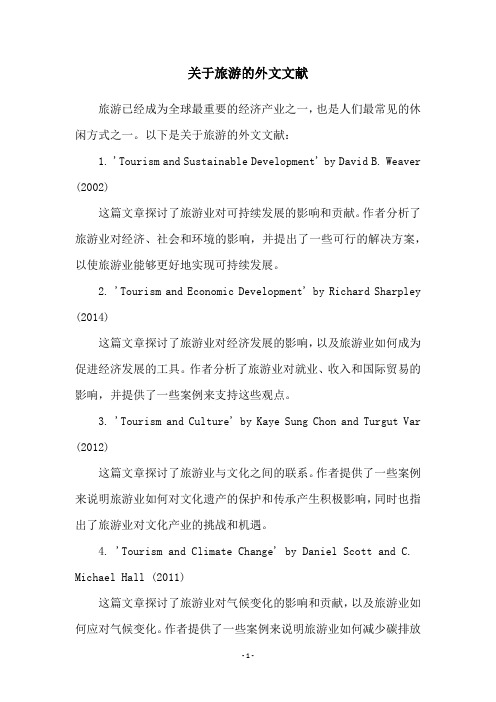
关于旅游的外文文献旅游已经成为全球最重要的经济产业之一,也是人们最常见的休闲方式之一。
以下是关于旅游的外文文献:1. 'Tourism and Sustainable Development' by David B. Weaver (2002)这篇文章探讨了旅游业对可持续发展的影响和贡献。
作者分析了旅游业对经济、社会和环境的影响,并提出了一些可行的解决方案,以使旅游业能够更好地实现可持续发展。
2. 'Tourism and Economic Development' by Richard Sharpley (2014)这篇文章探讨了旅游业对经济发展的影响,以及旅游业如何成为促进经济发展的工具。
作者分析了旅游业对就业、收入和国际贸易的影响,并提供了一些案例来支持这些观点。
3. 'Tourism and Culture' by Kaye Sung Chon and Turgut Var (2012)这篇文章探讨了旅游业与文化之间的联系。
作者提供了一些案例来说明旅游业如何对文化遗产的保护和传承产生积极影响,同时也指出了旅游业对文化产业的挑战和机遇。
4. 'Tourism and Climate Change' by Daniel Scott and C. Michael Hall (2011)这篇文章探讨了旅游业对气候变化的影响和贡献,以及旅游业如何应对气候变化。
作者提供了一些案例来说明旅游业如何减少碳排放和推广可再生能源等方面的努力。
5. 'Tourism and Technology' by Dimitrios Buhalis and Adele Ladkin (2015)这篇文章探讨了旅游业与技术之间的联系。
作者分析了移动设备、社交媒体、虚拟现实等技术对旅游业的影响,并提出了一些未来的趋势和挑战。
旅游外文期刊推荐

旅游外文期刊推荐1. Annals of Tourism Research《旅游研究纪事》英国ISSN:0160-7383,1974年创刊,全年4期,Elsevier Science出版社,SSCI收录期刊,SSCI 2003年影响因子0.555。
刊载旅游与有关的人类学、社会学、地理学、教育、管理以及旅游业与其他公共事业的关系方面的报告、札记和简讯。
文章多用英文发表,间用法文。
QuarterlyISSN: 0160-7383PERGAMON-ELSEVIER SCIENCE LTD, THE BOULEVARD, LANGFORD LANE,KIDLINGTON, OXFORD, ENGLAND, OX5 1GB2. International Journal of Tourism Research《国际旅游研究杂志》美国ISSN:1099-2340,1999年创刊,全年6期,John Wiley出版社,为旅游与接待业提供一个学术研究论坛,发表论文、会议报告和书评等。
3. International Journal of Hospitality Management《国际接待业管理杂志》英国ISSN:0278-4319,1982年创刊,全年4期,Elsevier Science出版社,刊载研究各国旅游服务业的管理、计划与规章、旅客接待、服务人员培训与教育、公关与市场开拓等方面的文章与评论。
3. INTERNATIONAL JOURNAL OF HOSPITALITY MANAGEMENT 《国际接待业管理杂志》英国QuarterlyISSN: 0278-4319ELSEVIER SCI LTD, THE BOULEVARD, LANGFORD LANE, KIDLINGTON, OXFORD, ENGLAND, OXON, OX5 1GB4. Tourism Management《旅游管理》英国ISSN:0261-5177,1980年创刊,全年6期,Elsevier Science出版社,SSCI收录期刊,SSCI 2003年影响因子0.518。
英语作文:假期旅游 On Holiday Travel

英语作文:假期旅游 On Holiday TravelFor most people, they will choose to travel during holiday because they want to relieve themselves from the highpressure of work. However, it happens quite often that people often ran into traffic jams on the way to travel. Some people think that we can relax ourselves by traveling no matter of how many people there. Some people would rather to stay in home than going out to travel because they think there aretoo many people swarm into the scenic spots. In my point of view, I would rather to stay indoors rather than going out to travel. Reasons are listed below.对于很多人来说,都会选择假期旅游,因为他们想要从巨大的工作压力中解放自己。
但是,在去旅游的路上遇到交通堵塞的事情经常发生。
一些人认为不管有多少人,我们还是能够通过旅游来放松自己。
一些人情愿呆在家里也不远出去旅游,因为他们觉得旅游景点的人太多了。
就我看来,我情愿呆在家里也不远走出去旅游。
原因如下:Firstly, during holiday, so many people swarm into thetravel spots that we can't enjoy ourselves to the full. For most people, they want to travel because during holiday, they can have several days to relieve themselves by traveling. However, so many people crowd together will make their tour lose the original fun.第一,在假期期间,太多的人聚集在旅游景点,我们不能玩的很实行。
假期出门去旅行的英文作文

假期出门去旅行的英文作文Traveling during the HolidaysDuring the holidays, it's a wonderful time to step out of our dly routines and embark on an exciting journey. I love traveling during this special period as it allows me to explore new places, experience different cultures, and create memories that will last a lifetime.One of the reasons I enjoy traveling during the holidays is the opportunity to relax and unwind. After a busy year of work and study, getting away from the stress of dly life and immersing myself in a new environment is truly rejuvenating. Whether it's the beach, in the mountns, or in a bustling city, there's always something that can soothe my soul and make me feel at peace.Another great aspect of traveling during the holidays is the chance to spend quality time with my family and friends. It's a perfect opportunity to bond with them and create shared experiences that we can cherish for years to e. We can explore new attractions together, have delicious meals, and engage in fun activities that bring us closer.When it es to choosing a destination for my holiday trip, I usually consider my interests and preferences. If I love nature, I might head to a scenic national park or a beautiful countryside. If I'm a history buff, I'll look for historical sites and museums to explore. And if I'm in the mood for some adventure, I might choose a destination with exciting outdoor activities like hiking, skiing, or surfing.During my travels, I also make it a point to immerse myself in the local culture. Trying local food, visiting local markets, and interacting with the locals gives me a deeper understanding and appreciation of the place. I learn about their traditions, customs, and way of life, which broadens my horizons and enriches my travel experience.Of course, traveling during the holidays also es with its challenges. It can be more crowded in popular tourist destinations, and there may be longer queues and higher prices. But despite these minor inconveniences, I find that the joy and excitement of exploring outweigh any difficulties. I believe that with properplanning and a flexible attitude, I can make the most of my holiday trip and have a memorable time.Overall, traveling during the holidays is a wonderful way to recharge and have fun. It allows me to step out of my fort zone, discover new things, and grow as a person. So, if you have the chance, I highly remend taking a holiday trip and experiencing the beauty and wonders of the world. You won't regret it!。
国庆节去旅行英语作文
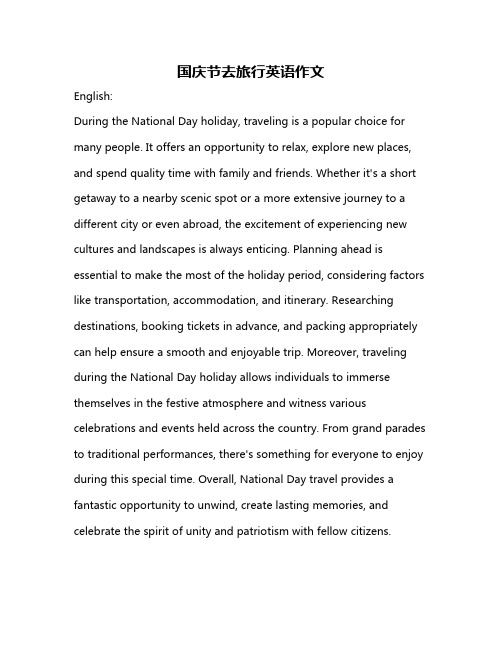
国庆节去旅行英语作文English:During the National Day holiday, traveling is a popular choice for many people. It offers an opportunity to relax, explore new places, and spend quality time with family and friends. Whether it's a short getaway to a nearby scenic spot or a more extensive journey to a different city or even abroad, the excitement of experiencing new cultures and landscapes is always enticing. Planning ahead is essential to make the most of the holiday period, considering factors like transportation, accommodation, and itinerary. Researching destinations, booking tickets in advance, and packing appropriately can help ensure a smooth and enjoyable trip. Moreover, traveling during the National Day holiday allows individuals to immerse themselves in the festive atmosphere and witness various celebrations and events held across the country. From grand parades to traditional performances, there's something for everyone to enjoy during this special time. Overall, National Day travel provides a fantastic opportunity to unwind, create lasting memories, and celebrate the spirit of unity and patriotism with fellow citizens.中文翻译:国庆节假期期间,旅行是许多人的首选。
假期研学旅行活动英语作文
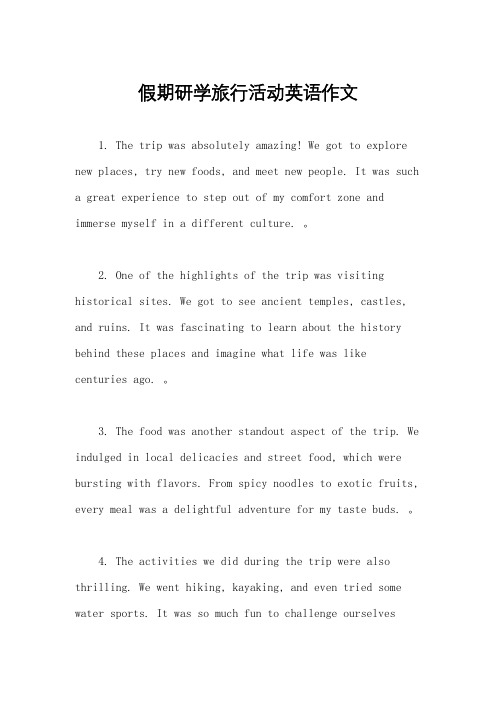
假期研学旅行活动英语作文1. The trip was absolutely amazing! We got to explore new places, try new foods, and meet new people. It was such a great experience to step out of my comfort zone and immerse myself in a different culture. 。
2. One of the highlights of the trip was visiting historical sites. We got to see ancient temples, castles, and ruins. It was fascinating to learn about the history behind these places and imagine what life was like centuries ago. 。
3. The food was another standout aspect of the trip. We indulged in local delicacies and street food, which were bursting with flavors. From spicy noodles to exotic fruits, every meal was a delightful adventure for my taste buds. 。
4. The activities we did during the trip were also thrilling. We went hiking, kayaking, and even tried some water sports. It was so much fun to challenge ourselvesphysically and enjoy the beautiful natural scenery at the same time. 。
十一假期游玩英语作文
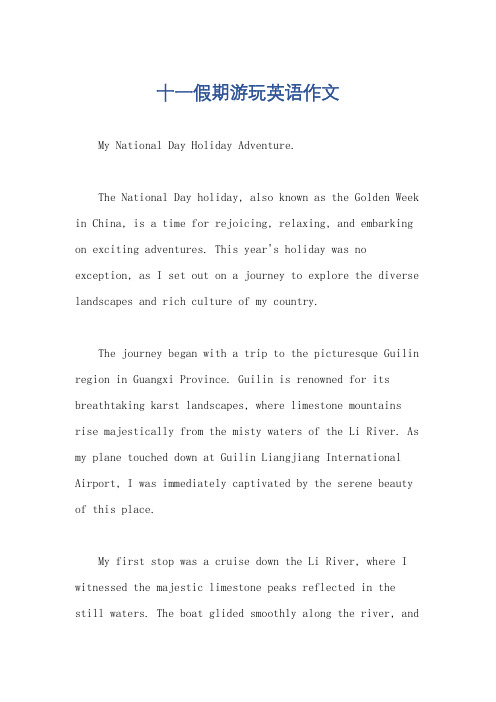
十一假期游玩英语作文My National Day Holiday Adventure.The National Day holiday, also known as the Golden Week in China, is a time for rejoicing, relaxing, and embarking on exciting adventures. This year's holiday was no exception, as I set out on a journey to explore the diverse landscapes and rich culture of my country.The journey began with a trip to the picturesque Guilin region in Guangxi Province. Guilin is renowned for its breathtaking karst landscapes, where limestone mountains rise majestically from the misty waters of the Li River. As my plane touched down at Guilin Liangjiang International Airport, I was immediately captivated by the serene beauty of this place.My first stop was a cruise down the Li River, where I witnessed the majestic limestone peaks reflected in thestill waters. The boat glided smoothly along the river, andI marveled at the unique formations of the mountains, each one resembling a different shape or creature. The scenery was so serene and peaceful that it felt like a painting come to life.After the river cruise, I visited the Elephant Trunk Hill, a famous landmark in Guilin. Its distinctive shape, resembling an elephant drinking water from the river, is truly remarkable. I walked around the base of the hill, admiring its grandeur and taking plenty of photos to capture this unforgettable sight.From Guilin, I traveled to Zhangjiajie in Hunan Province, known for its spectacular natural wonders. The towering sandstone peaks of Zhangjiajie National.。
度假和旅行英文作文
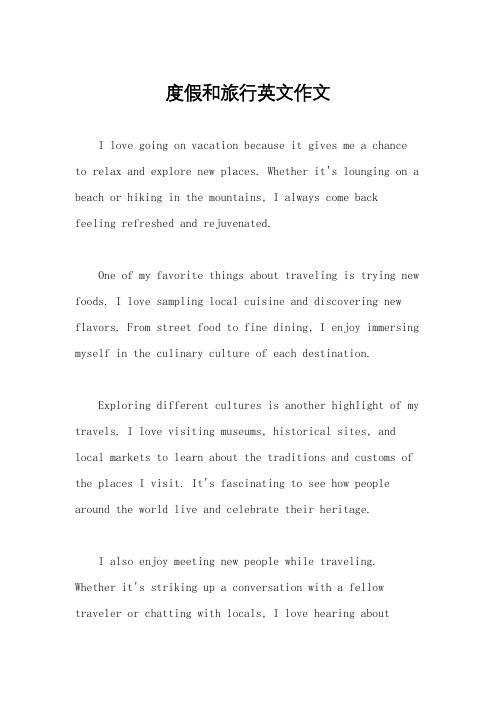
度假和旅行英文作文I love going on vacation because it gives me a chance to relax and explore new places. Whether it's lounging on a beach or hiking in the mountains, I always come backfeeling refreshed and rejuvenated.One of my favorite things about traveling is trying new foods. I love sampling local cuisine and discovering new flavors. From street food to fine dining, I enjoy immersing myself in the culinary culture of each destination.Exploring different cultures is another highlight of my travels. I love visiting museums, historical sites, and local markets to learn about the traditions and customs of the places I visit. It's fascinating to see how people around the world live and celebrate their heritage.I also enjoy meeting new people while traveling. Whether it's striking up a conversation with a fellow traveler or chatting with locals, I love hearing abouttheir experiences and sharing stories. It's amazing how travel can bring people together from all walks of life.Traveling allows me to step out of my comfort zone and try new things. Whether it's learning a new language, trying a new activity, or simply navigating a new city, I love the sense of adventure and discovery that comes with exploring the world.Overall, traveling is a transformative experience that allows me to broaden my horizons, make lasting memories, and appreciate the beauty and diversity of our world. I can't wait for my next adventure!。
假期旅行澳门英文作文
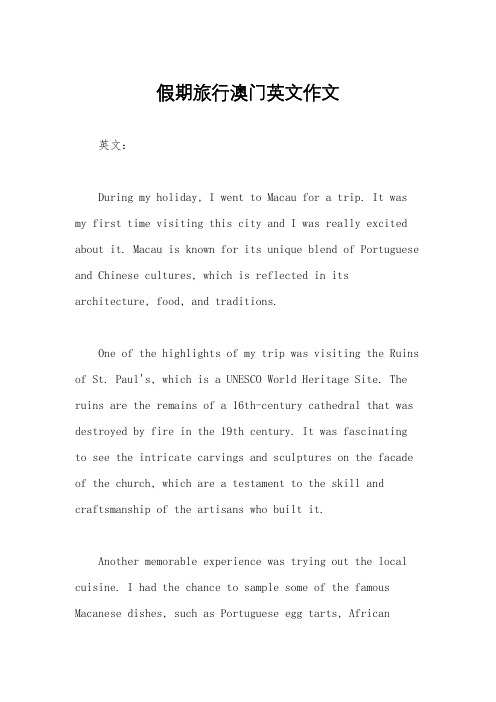
假期旅行澳门英文作文英文:During my holiday, I went to Macau for a trip. It was my first time visiting this city and I was really excited about it. Macau is known for its unique blend of Portuguese and Chinese cultures, which is reflected in its architecture, food, and traditions.One of the highlights of my trip was visiting the Ruins of St. Paul's, which is a UNESCO World Heritage Site. The ruins are the remains of a 16th-century cathedral that was destroyed by fire in the 19th century. It was fascinating to see the intricate carvings and sculptures on the facade of the church, which are a testament to the skill and craftsmanship of the artisans who built it.Another memorable experience was trying out the local cuisine. I had the chance to sample some of the famous Macanese dishes, such as Portuguese egg tarts, Africanchicken, and pork chop buns. The food was a delicious fusion of Chinese and Portuguese flavors, and I enjoyed every bite.Overall, my trip to Macau was a wonderful experience. I learned a lot about the city's history and culture, and I had a great time exploring all the different sights and sounds.中文:我假期的时候去了澳门旅行。
假期去旅行英文怎么写作文
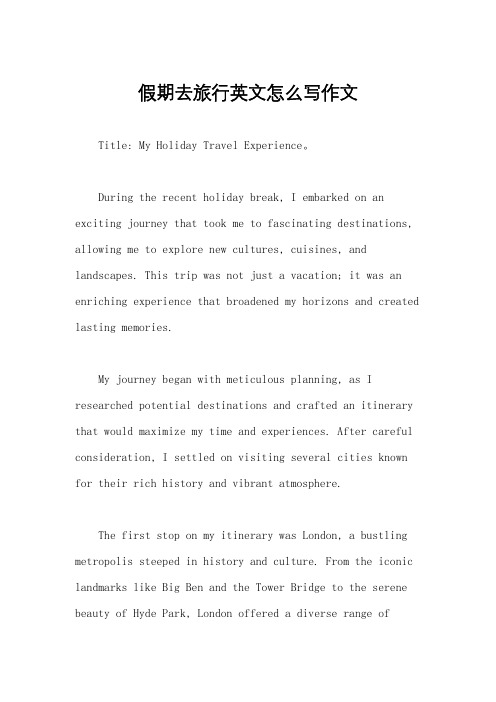
假期去旅行英文怎么写作文Title: My Holiday Travel Experience。
During the recent holiday break, I embarked on an exciting journey that took me to fascinating destinations, allowing me to explore new cultures, cuisines, and landscapes. This trip was not just a vacation; it was an enriching experience that broadened my horizons and created lasting memories.My journey began with meticulous planning, as I researched potential destinations and crafted an itinerary that would maximize my time and experiences. After careful consideration, I settled on visiting several cities known for their rich history and vibrant atmosphere.The first stop on my itinerary was London, a bustling metropolis steeped in history and culture. From the iconic landmarks like Big Ben and the Tower Bridge to the serene beauty of Hyde Park, London offered a diverse range ofexperiences. I spent my days exploring museums, strolling through charming neighborhoods, and indulging intraditional British cuisine.Next, I traveled to Paris, the city of love and lights. Walking along the Seine River, I marveled at the breathtaking architecture and romantic ambiance that permeated every corner of the city. Visits to the Louvre and the Eiffel Tower allowed me to appreciate the art and history that define Parisian culture. Sampling delicate pastries at local patisseries and sipping coffee at quaint cafes became cherished rituals during my stay.After Paris, I ventured into the picturesque countryside of Tuscany, Italy. Surrounded by rolling hills and vineyards, I was enchanted by the rustic charm of this region. Exploring medieval towns like Siena and San Gimignano felt like stepping back in time, while wine tastings at local wineries provided a taste of the region's rich culinary heritage.As my journey continued, I found myself immersed in thevibrant energy of Barcelona, Spain. From the architectural wonders of Antoni Gaudí to the lively markets of La Rambla, every moment in Barcelona was filled with excitement and wonder. Sampling tapas and paella allowed me to savor the flavors of Spanish cuisine, while flamenco performances captivated me with their passion and intensity.Throughout my travels, I encountered people from all walks of life, each with their own stories to share. Whether it was striking up a conversation with a local shopkeeper or exchanging travel tips with fellow adventurers, these interactions added depth and meaning to my journey.As I reflect on my holiday travel experience, I amfilled with gratitude for the opportunity to explore the world and immerse myself in new cultures. Each destination left an indelible mark on my heart, reminding me of the beauty and diversity that exists within our world. Thoughmy holiday may have come to an end, the memories and experiences I gained will stay with me forever, inspiring future adventures yet to come.。
假期到内蒙古旅游英语作文
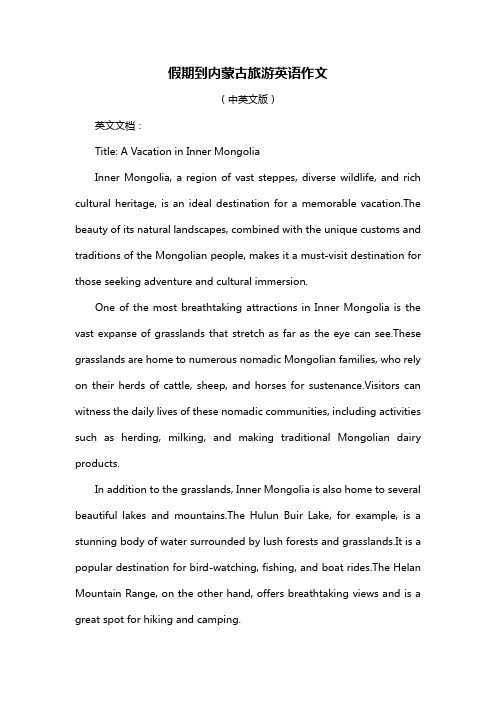
假期到内蒙古旅游英语作文(中英文版)英文文档:Title: A Vacation in Inner MongoliaInner Mongolia, a region of vast steppes, diverse wildlife, and rich cultural heritage, is an ideal destination for a memorable vacation.The beauty of its natural landscapes, combined with the unique customs and traditions of the Mongolian people, makes it a must-visit destination for those seeking adventure and cultural immersion.One of the most breathtaking attractions in Inner Mongolia is the vast expanse of grasslands that stretch as far as the eye can see.These grasslands are home to numerous nomadic Mongolian families, who rely on their herds of cattle, sheep, and horses for sustenance.Visitors can witness the daily lives of these nomadic communities, including activities such as herding, milking, and making traditional Mongolian dairy products.In addition to the grasslands, Inner Mongolia is also home to several beautiful lakes and mountains.The Hulun Buir Lake, for example, is a stunning body of water surrounded by lush forests and grasslands.It is a popular destination for bird-watching, fishing, and boat rides.The Helan Mountain Range, on the other hand, offers breathtaking views and is a great spot for hiking and camping.Inner Mongolia is also known for its rich cultural heritage.The Mongolian people have a unique culture, with a proud history of horsemanship, traditional music, and unique architectural styles.Visitors can experience this culture firsthand by attending local festivals, such as the Naadam Festival, which showcases traditional Mongolian sports, music, and dance.Furthermore, Inner Mongolia is home to several important historical sites.The Mongolian Parliament Building, for example, is a impressive structure that stands as a symbol of Mongolian sovereignty and independence.The Ordos Museum, on the other hand, offers a comprehensive overview of the region"s history and culture.In conclusion, Inner Mongolia is a beautiful and diverse region that offers something for everyone.Whether you are interested in nature, culture, or history, Inner Mongolia has something to offer.So, if you are looking for a unique and memorable vacation destination, consider visiting Inner Mongolia.中文文档:标题:假期到内蒙古旅游内蒙古,这片广阔的草原、多样的野生动物和丰富的文化遗产,是一个令人难忘的假期的理想目的地。
国庆假期行程范文英文
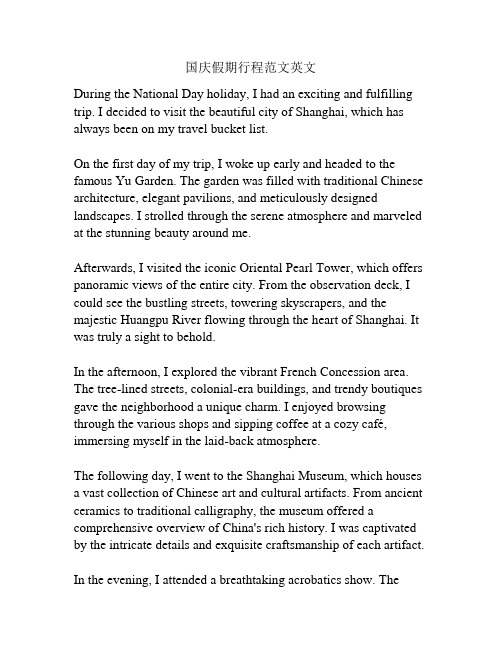
国庆假期行程范文英文During the National Day holiday, I had an exciting and fulfilling trip. I decided to visit the beautiful city of Shanghai, which has always been on my travel bucket list.On the first day of my trip, I woke up early and headed to the famous Yu Garden. The garden was filled with traditional Chinese architecture, elegant pavilions, and meticulously designed landscapes. I strolled through the serene atmosphere and marveled at the stunning beauty around me.Afterwards, I visited the iconic Oriental Pearl Tower, which offers panoramic views of the entire city. From the observation deck, I could see the bustling streets, towering skyscrapers, and the majestic Huangpu River flowing through the heart of Shanghai. It was truly a sight to behold.In the afternoon, I explored the vibrant French Concession area. The tree-lined streets, colonial-era buildings, and trendy boutiques gave the neighborhood a unique charm. I enjoyed browsing through the various shops and sipping coffee at a cozy café, immersing myself in the laid-back atmosphere.The following day, I went to the Shanghai Museum, which houses a vast collection of Chinese art and cultural artifacts. From ancient ceramics to traditional calligraphy, the museum offered a comprehensive overview of China's rich history. I was captivated by the intricate details and exquisite craftsmanship of each artifact. In the evening, I attended a breathtaking acrobatics show. Theperformers showcased their incredible agility, strength, and balance through breathtaking stunts and daring acts. The show left me in awe and reminded me of the immense talent and dedication required to master such skills.On the third day, I took a relaxing cruise along the Huangpu River. The cruise allowed me to admire the city's skyline from a different perspective. As the boat glided past the futuristic skyscrapers, I couldn't help but marvel at the rapid development and modernization of Shanghai.In the afternoon, I visited the Shanghai World Financial Center, known as the "Bottle Opener" due to its distinctive shape. I rode the high-speed elevator to the observation deck on the 100th floor, where I was greeted with breathtaking views of the cityscape. It was truly a moment of awe-inspiring beauty.During the last day of my trip, I decided to explore the famous Nanjing Road, one of the world's busiest shopping streets. I wandered through the bustling crowds, browsing through the countless shops and department stores. I couldn't resist the temptation and ended up purchasing some souvenirs to commemorate my trip.Overall, my National Day holiday in Shanghai was an incredible experience. The city's rich history, modern skyline, and vibrant culture left me with unforgettable memories.。
假期旅行英语作文(通用27篇)
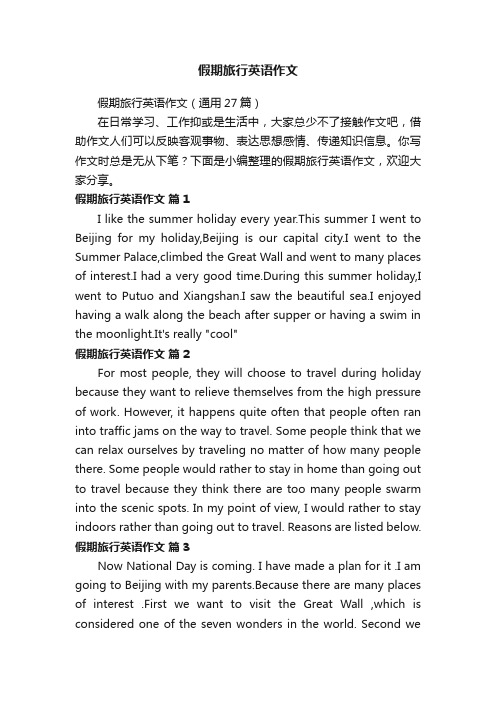
假期旅行英语作文假期旅行英语作文(通用27篇)在日常学习、工作抑或是生活中,大家总少不了接触作文吧,借助作文人们可以反映客观事物、表达思想感情、传递知识信息。
你写作文时总是无从下笔?下面是小编整理的假期旅行英语作文,欢迎大家分享。
假期旅行英语作文篇1I like the summer holiday every year.This summer I went to Beijing for my holiday,Beijing is our capital city.I went to the Summer Palace,climbed the Great Wall and went to many places of interest.I had a very good time.During this summer holiday,I went to Putuo and Xiangshan.I saw the beautiful sea.I enjoyed having a walk along the beach after supper or having a swim in the moonlight.It's really "cool"假期旅行英语作文篇2For most people, they will choose to travel during holiday because they want to relieve themselves from the high pressure of work. However, it happens quite often that people often ran into traffic jams on the way to travel. Some people think that we can relax ourselves by traveling no matter of how many people there. Some people would rather to stay in home than going out to travel because they think there are too many people swarm into the scenic spots. In my point of view, I would rather to stay indoors rather than going out to travel. Reasons are listed below. 假期旅行英语作文篇3Now National Day is coming. I have made a plan for it .I am going to Beijing with my parents.Because there are many places of interest .First we want to visit the Great Wall ,which is considered one of the seven wonders in the world. Second wewant to visit the summer palace ,where lived many emperors during the hot days. Then we want to visit the Water Cube,where many important events are held .Finally we want to visit hutong to get a knowledge of the culture of old Beijing .I think this trip must be very interesting and we will have a good time.假期旅行英语作文篇4Travel is a very good means of broadening a person's perspective. It makes you come into contact with different cultures,meet people of different colors and go through peculiar rites and ceremonies. Travelling much, you will not only enrich your knowledge and experiences, but also be aware of the vastness of nature.Travel may also relieve person of boredom and gloom. Travel brings you enjoyment and attraction. It gives you a pleasant experience,which will disperse your boredom and make you forget whatever annoys you. Travel broadens your mind and leaves you good memories. Later,you may go over these memories and enjoy your past experiences,thus keeping a fresh and sunny mind.假期旅行英语作文篇5Now National Day is ing. I have made a plan for it .I am going to Beijing with my parents.Because there are many places of interest .First we want to visit the Great Wall ,which is considered one of the seven wonders in the world. Second we want to visit the summer palace ,where lived many emperors during the hot days. Then we want to visit the Water Cube,where many important events are held .Finally we want to visit hutong to get a knowledge of the culture of old Beijing .I think this trip must be very interesting and we will have a good time.假期旅行英语作文篇6My holiday was very interesting. I did my homework on first day. I played tennis on second day. I watch TV on the third day. I went to shopping on the fourth day. ?I ..... but i like going shopping best. On Sunday,I went to a shopping mall was very big. There were all kinds of things.Everyday a lot of people go there to buy things .I was helping my mother to buy things. ?I had a shopping list in my hand. We were looking for things on the shopping list. After staying in the shopping mall About two hours. We got all the things and back home. I have a good holiday!我的假期很有趣。
- 1、下载文档前请自行甄别文档内容的完整性,平台不提供额外的编辑、内容补充、找答案等附加服务。
- 2、"仅部分预览"的文档,不可在线预览部分如存在完整性等问题,可反馈申请退款(可完整预览的文档不适用该条件!)。
- 3、如文档侵犯您的权益,请联系客服反馈,我们会尽快为您处理(人工客服工作时间:9:00-18:30)。
FESTIVAL TOURISM IN THE CARIBBEAN: An Economic Impact AssessmentPrepared by:Dr. Keith NurseInstitute of International Relations,University of the West Indies,Trinidad & TobagoTel: 868 633 1902Fax: 868 663 9685Email: keith@Prepared for:Inter-American Development BankWashington D.C.USAMay 2001EXECUTIVE SUMMARYRATIONALEThe tourism sector, which is the mainstay of most Caribbean economies, is faced with increased competition and new demand conditions. One ofthe key growth trends in the global tourism industry is the diversification ofthe tourism product away from high-impact mass tourism toward specialtyor niche markets like cultural tourism. Festival tourism is a sub-componentof cultural tourism and has experienced significant growth in the lastdecade as tourist planners have come to recognize the demand-pull of the arts, popular music, entertainment and themed events.Throughout the Caribbean festival tourism is gaining prominence in the tourism calendar. In many respects this growth is built on the success of a few festivals:o Reggae Sunsplash in Jamaica, which started in the late 1970s and was succeeded by Reggae Sumfest in the early 1990s, can be viewed as thepioneer in terms of festival tourism in the Caribbean in the way in whichthe internationalization of reggae music became a magnet for tourism.o Trinidad Carnival, which is a model to many regional and overseas Caribbean carnivals, has evolved into a festival tourism product and anentertainment industry not from strategic intervention but through anorganic process of community development, aesthetic innovation anddiasporic relations.o Santo Domingo’s Festival de Merengue is an outdoor week-long celebration which was originally sparked by Puerto Rican visitors in thelate 1960s and has been fuelled by summer travel by the large diasporicDominican population.o The St. Lucia Jazz Festival from inception was geared towards creating a demand-pull in a trough period in the tourism calendar. The festival hashad strong media appeal and attracts an up-market audience ofinternational and intra-regional tourists.o The Barbados Cropover festival, originally a sugar cane harvest festival, was revived by the national tourism agency in 1974 to fill the void in thetourism off-season. The festival attracts mainly overseas nationals andintra-regional visitors.o The St. Kitts Music Festival, which features multiple genres of music, was started in 1996 to act as a demand-pull for visitors in the low touristseason and to generate media exposure for the tourist destination.Returning nationals and intra-regional visitors are the major patrons.Each of these festivals is observed to have a significant impact on visitor arrivals, airlifts and hotel occupancy rates with spillover effects on media industries, local transport (e.g. car rentals) and the food, beverage and restaurant sectors. Actual data on the economic impact of these festivals is largely un-documented, however. Where there is data the impact has been considerable.APPROACHThe goal of the research project is to improve our knowledge on how festivals work and the contribution they make to the economy and society. The research task involves:1. A survey of festival management focusing on the specifics of eachtargeted festival (via a questionnaire): historical background of thefestival, the programme and activities, organization and staffing,budget and finances, marketing and promotion.2. An economic impact assessment, which involves an evaluation ofthe direct contribution of festival tourism on the hotel, airline andentertainment industries. The analysis will specifically look at touristarrivals, hotel occupancy rates, visitor expenditures, tax revenues,employment generation and media value. The impact assessmentwill include a cost-benefit evaluation and an analysis of the divisionof costs and surpluses.Six festivals in six territories were identified for investigation: Barbados, the Dominican Republic, Jamaica, St. Kitts, St. Lucia and Trinidad and Tobago. The study examined six festivals that fall into three major sub-categories:1. Carnival Festivals: these festivals are indigenous and composite in thatthey include music, dance and masquerade arts.•Trinidad and Tobago – Trinidad Carnival.•Barbados – the Crop Over Festival.2. Indigenous Music Festivals: these festivals are based on the exposition ofan indigenous music to a local and foreign clientele.•Jamaica – Reggae Sunsplash and Sumfest.•Dominican Republic - the Merengue Festival.3. Tourist-oriented Music Festivals – these festivals were created to boosttourist arrivals. The performers and clientele are primarily foreign-based.•St. Lucia – the St. Lucia Jazz festival.•St. Kitts & Nevis – the St. Kitts Music festival.GENERAL FINDINGSThe Caribbean festivals studied have made a significant impact on the tourism sector in terms of creating a new tourism season and/or filling the void in the tourism calendar by boosting airlifts and improving hoteloccupancy levels.Caribbean festivals have done much to generate new tourism demand from the short break travel market, as well as from diasporic and intra-regional tourist, groupings that are largely omitted in the tourist marketing plans of most Caribbean tourism organizations.The spending of festival tourists, which is considered “new” or incremental and counts as an export industry, has been very significant as a share oftotal visitor expenditure, where the data on visitor arrivals has beendocumented by exit surveys.Festival tourists are observed to be quite knowledgeable about the art forms and the region’s culture and history. Their spending habits are such that they tend to stay longer and spend more on local goods and services than the conventional tourist. They also tend to be repeat visitors andgood word-of-mouth spoke-persons.High calibre (e.g. jazz and indigenous music festivals) and unique Caribbean festivals (e.g. carnivals) have an up-market appeal, attractinternational media and have proved to be a cost effective means to gainmedia exposure (e.g. publicity) and enhance the image and attractiveness of a tourist destination.Caribbean festivals have been pivotal, especially carnivals and indigenous music festivals, in the development of an entertainment sector with export capabilities. Festivals give a fillip to the entertainment sector throughcreating new clients, markets and media exposure. It also stimulatesinfrastructure development, heritage conservation and investment into the arts.Festival tourism in the Caribbean makes an important contribution to the wider economy in that it increases government tax receipts, generatesemployment and sectoral linkages, attracts business sponsorship & cross promotions and has a spillover effect on ancillary sectors like the mediaand advertising industries, auto rentals and restaurants.Successful festivals build the society’s cultural confidence and image of self-worth and identity. In this way it creates a synergistic relationshipbetween the tourism industry and community development.Governments throughout the region have begun to incorporate festivals ina tourism development strategy. However, policy formulation and relatedresearch (e.g. economic impact assessments) have lagged behind andlimited efforts have been made to invest in the development andinfrastructure in the arts and cultural industries.ECONOMIC IMPACT: THE CASE STUDIESOf the six festivals studied only three festivals (Trinidad Carnival, St. Lucia Jazz and Barbados Cropover) have done exit surveys, which providequality data on visitor arrivals and expenditures. The following tableprovides an overview of the economic impact of the festivals.SUMMARY OF ECONOMIC IMPACT (1998)Trinidad Carnival St. Lucia Jazz BarbadosCropoverBudgetUS$mn2.0 1.55 1.021Visitor arrivals(number)32,071 9,929 4,428Share of annualvisitor arrivals9.2 3.9 0.86Visitor expenditureUS$mn.14.08 14.15 2.42Share of annualvisitor expenditure7.6 4.9 0.34Cost-benefit ratio:visitorexpenditure./budget704 913 237Hotel occupancy rate(%)95 74.5 53.3Visitor expenditure.on entertainmentUS$mn3.1 n.d. 0.240Departure taxesUS$mn0.517 0.099 0.055The main finding of the study is that festivals create a strong demand-pull for visitors. The best case is that of Trinidad carnival which accounted for9.2% of arrivals and 7.6% of visitor expenditures for the year 1998. Thefestival with the next best performance was that of St. Lucia Jazz, whichcontributed 3.9% of visitors and 4.9% of visitor expenditures. In the caseof Barbados the Cropover festival accounted for 0.86% of annual touristarrivals. The respective share of annual tourist expenditures was 0.34%.Most festivals impact positively on hotel occupancy levels.o The best example of how festivals impact on an off-season is that of St.Lucia where the month of May was converted from the worst touristmonth to a position where it now enjoys above average occupancy levels(74.5%).o A comparable example is the case of Reggae Sunsplash in Montego, Jamaica. When compared with a peak week (first week in February) inthe winter tourist season hotel occupancy levels in the week of Sunsplashaveraged fourteen percentage points higher for eleven years, 1981 and1983 to 1992.o The case of the Dominican Republic is also instructive. Arrivals and hotel occupancy levels in Santo Domingo jump in the month of July when theMerengue festival occurs. Over the period 1995 to 1999 the month of Julyaveraged an occupancy rate of 71.7%, which puts it as the third highestmonth.o In the case of Trinidad carnival the festival is able to generate occupancy rates above 90%. This is achievable in Trinidad because of the largenumber of visitors and the fact that the hotel plant is small in relativeterms.The festivals make a measurable impact on government taxes. The most illustrative case is that of the Trinidad Carnival. The festival has a large number of visitors and generates departure taxes of US$0.5 million, one-quarter of the budget of the festival. There are other tax benefits. When value-added taxes (15%) are applied to visitor expenditures of US$14.08 government earns US$2.1 million in indirect taxes. The combined effect is that taxes generated by the festival exceed government’s initial investment of US$2.0 million by approximately $600,000.Festivals are not known for generating a large number of jobs or year-round employment, at least not directly. In this study it is notable that: o The carnival type festivals (Trinidad Carnival and Barbados Cropover) have spawned entertainment industries that generate employment forartists and cultural entrepreneurs during the season and year round.o During the 1998 Trinidad Carnival the sale of carnival related goods and services amounted to US$3.1 million. In Barbados the entertainmentrelated expenditures for 1998 were $240,000.o Year round employment is generated in the local and regional hospitality sector in addition to overseas performances in Caribbean carnivals andother festivals throughout the region and in North America, Europe andJapan.o The indigenous music festivals (the Merengue Festival and Reggae Sunsplash and Sumfest) have also impacted positively on their respectivemusic industries which are estimated to earn over US$50 million in theexport of goods and services.Media value is one of the key benefits that these festivals provide to the host economy. The St. Lucia Tourist Board estimates that the media value of the Jazz festival is in excess of the budget of the festival. The tourist-inspired festivals have attracted stronger media value than the other festivals. The foreign music genres facilitate easier access to international media and broadcast networks. The carnivals and the indigenous music festivals have found it far more difficult to gain such media value because of the limited exposure the art forms and the genres of music currently attract.The benefit-to-cost analysis indicates that most festivals have a healthy yield or return on investment. The festival with the highest estimated benefit-to-cost ratio is that of the St. Lucia Jazz festival with 9.1:1. Trinidad Carnival is ranked second with a ratio of 7:1. Barbados Cropover generated a ratio of 2.4:1. These ratios, especially of St. Lucia and Trinidad, appear to be very competitive when compared with top international festivals like the Edinburgh Arts Festival, which generated a benefit-to-cost ratio of 11:1.ISSUES AND RECOMMENDATIONSThe festival context in the Caribbean is such that there are an increasing number of festivals, particularly music festivals. Countries like Barbados and St. Lucia have developed what can be described as a festival tourism strategy.One of the emerging problems associated with this development is the increase in regional competition. This is particularly evident in the proliferation of jazz festivals.The increased competition in festival tourism is also occurring with the carnivals. Countries like St. Lucia, Jamaica, Barbados, St. Vincent and the Grenadines and Antigua have been aggressively promoting their carnivals in the last few years. A problem of product differentiation has begun to arise as most of the carnivals source many of the same artists.Marketing is one of the critical areas for upgrading among festival organizers. Most of the festivals lack marketing plans with clearly definedtarget markets and visitor profiles, as well as advertising and promotions strategies.One of the critical issues facing the various festivals is the problem of a shortage of trained personnel in the area of festival management. There isa dependence on foreign expertise in external marketing, artistprocurement and stage management. Technical skills such as sound, lighting and stage are competitively procured from within the region.Financial management and reporting is one of the weakest areas for festival organizers. For example, most of the festivals are not able to communicate effectively the yield and benefits of the festival relative to the costs.Business sponsorship is another weak area of festival management. This is so because the corporate community has had limited experience with festival and arts sponsorship and many festival organizers don’t have skills in writing business and sponsorship proposals.In most Caribbean territories there is a shortage of appropriate indoor and outdoor venues for the performing arts. This impacts negatively on audience development as well as media coverage. This is an aspect of the economy that has suffered from market failure and government disinterest.A key recommendation is for the creation of a regional association offestival organizations. There is much scope for industry collaboration in training, joint marketing, cross-promotions, the pooling of resources and the joint procurement of technical services.The success of Caribbean festivals has been built on the calibre of the artists and the quality of the experience. Most new festivals need a gestation period of three to five years before they show some positive yield and benefit. Festivals require a sizable investment upfront to establish the brand and reputation.Good festival management and planning requires proper measurement.Government participation or assistance in festivals should involve research and evaluation mechanisms. A key recommendation is that festival organizers need to continuously document and measure the economic impact of the festivals.。
